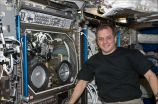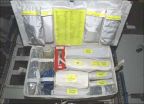CLEVELAND, OH, September 12, 2012 (Press-News.org) Imagine you're an astronaut exploring the surface of Mars, when suddenly you fall ill or injure yourself. As your team struggles to get you safely back to base, you become seriously dehydrated. With their trusty -- and ingenious -- kit, the medical officer hooks into the drinking water supply, using it to create a saline solution that they can inject directly into your blood stream for quick and safe rehydration.
That's the idea behind the Intravenous Fluid Generation for Exploration Missions, or IVGEN, investigation that was conducted on the space station over five days in the spring of 2010. Since standard IV fluid bags used in hospitals would be too costly to send and hard to keep from spoiling on long-duration space missions, the ability to make fresh saline right from the drinking water supply could save the day in emergency scenarios.
Using the station's current recycled drinking water, the IVGEN investigation demonstrated that it is possible to produce medical-grade saline in space. Now, the focus has turned to the longevity of the IVGEN hardware and the shelf life of the solution produced.
"Basically IVGEN was a project to verify that, somehow, we could take potable or drinking water, purify it, and mix it to make a normal, medical-grade saline solution that could be injected into astronauts if the need arose," said John McQuillen, IVGEN principal investigator at NASA's Glenn Research Center in Cleveland, Ohio.
The IVGEN experiment relied on U.S. Pharmacopeia, or USP, guidelines for producing purified water and medical-grade saline. USP is the authoritative source for medicine and healthcare product standards.
Water from the station's Water Processor Assembly was fed through IVGEN hardware, where a series of filters removed air, bacterial contaminates, particulates, and heavy metals upstream of the heart of the system. The water then continued on through an internal deionizing resin, similar to that used in home water purifiers, removing the bulk of the minerals and organics. The experiment produced six 1.5 liter bags, or about 2.5 gallons, of purified water.
Two of the six bags were used to produce medical-grade saline. To do that, the purified water was added to a bag containing a premeasured amount of salt and a magnetic stir bar for mixing. The resulting solution then was transferred to the final collection bag through a sterilizing filter, which removed any additional remaining air and bacteria.
Once back on Earth, the two bags of saline were shipped to a Food and Drug Administration-certified lab to test whether the contents complied with USP standards. In the meantime, the hardware was placed on the shelf to undergo lifetime testing and ground studies until needed for a future mission.
"We are now wrapping up testing of the post-flight hardware. This testing was performed to see what we can learn from the current state hardware, as opposed to when it was initially launched," said Terri McKay, IVGEN project scientist at Glenn. "We are also testing the filters to make sure they can satisfy missions of multiple year durations. The pharmaceutical product shelf life needs to be documented, as well."
IV fluids have a shelf life of 6 to 18 months. The concern is not just with the saline itself. Other issues need to be considered, such as the possibility during the manufacturing process of the introduction of germs into the saline. There also are potential concerns with the IV bag, such as a punctured seal that could allow germs to get into the solution. There's even the chance that the bags themselves may destabilize over time and begin leaching chemicals or plastic into the solution. Once in space, damaged IV bags and saline cannot be replaced with a simple phone call to a distributor.
"As far as I know, there has not been much need for saline in past missions. However, if there is a need for medical care on the space station, the astronaut can be back on Earth in 24 hours. But if you're halfway to Mars, you can't just turn around," said DeVon Griffin, IVGEN project manager at Glenn.
Astronauts, particularly those on missions to distant locations, need access to a medical kit that meets their immediate needs. That includes having good saline at the ready. Flight doctors produced a list of more than 400 medical conditions they are concerned about treating in space. Of that list, 115 require saline, including severe burns, acute anemia and broken bones.
To satisfy medical requirements for long-duration exploration missions, a spacecraft could be required to carry hundreds of liters of IV fluid. Spacecraft planners can ill afford to surrender the mass and volume needed to carry that much liquid, which weighs 2 pounds per liter, according to Griffin. One NASA estimate is that a mission to Mars may need to carry as much as 248 liters of IV fluids, or about 65 gallons of liquid that may not even be used. That equals nearly 500 pounds of liquid consuming precious room and weight: weight that costs approximately $10,000 a pound just to get into space.
With operational limitations, such as launch mass, storage, and tight legroom on spacecraft, exploration missions need to minimize the amount of IV fluid they transport. Either that, or the mission will need the capability to produce purified water and saline in space. IVGEN may provide the answer, using a single filtration system capable of producing many bags of IV fluid via a device that is smaller than a single bag of ready-to-use solution.
The proposed design of the IVGEN hardware for exploration missions is pretty compact. With the exception of the accumulator, which plugs into the potable water supply to get the source water, everything else could fit inside a small laptop computer. It would be about 1.5 inches thick with a footprint of around 8 by 11 inches, making it a real option for solving the problem of saline supplies in space.
For more information on past, ongoing, and future ISS research activities, including research results and publications, visit:
http://www.nasa.gov/mission_pages/station/research/index.html
For more information about Glenn's role in the International Space Station, visit:
http://www.nasa.gov/centers/glenn/shuttlestation/station/station_science.html
If you are interested in learning about the many benefits identified, visit:
http://www.nasa.gov/mission_pages/station/research/benefits/index.html
If you are interested in subscribing to updates from the ISS Program Science Office, visit:
https://lists.nasa.gov/mailman/listinfo/iss-program-science-group
For more information about the International Space Station, visit:
http://www.nasa.gov/station
A Solution for Medical Needs and Cramped Quarters in Space - IVGEN Undergoes Lifetime Testing in Preparation for Future Missions
RELEASE: JR12-008
2012-09-12
ELSE PRESS RELEASES FROM THIS DATE:
Firelight Fusion Electronic Cigarettes Offers Free Shipping and Lower Prices
2012-09-12
Firelight Fusion announced that they are now offering free shipping on all orders to help cut costs for smokers looking to make the jump from tobacco cigarette to the electronic cigarette.
Firelight Fusion's e cigarette starter kits are the most popular and highly trusted model in the U.S. The KR808D1 model is small so it mimics the look and feel of a tobacco cigarette while giving a cartomizer size that holds plenty of e liquid and produces a massive vapor by powering up with 280 mAh rechargable batteries. The parts are fairly low cost and available online from other ...
deVere Names Goldman Sachs Asset Management as One of the Preferred Fund Advisors
2012-09-12
Goldman Sachs Asset Management will provide deVere with access to a comprehensive range of global investment strategies and investment research across all major asset classes. In addition, Goldman Sachs Asset Management will offer sales support to deVere Financial Advisers worldwide.
The deVere Group CEO Nigel Green said, "deVere is proud with the relationship it has forged with Goldman Sachs Asset Management. As we continue to expand globally, amongst others, we aim to keep nurturing our services through Goldman Sachs Asset Management. We now look forward to start ...
Recording Artist Kristinia DeBarge Announces the Completion of her Latest Single Pick
2012-09-12
Recording artist Kristinia DeBarge announces the completion of her latest single pick, "Cry Wolf", scheduled to arrive in the marketplace on Thursday, September 27th.
The "Cry Wolf" video, directed by Cameron Alexander and Patrick Lawler, will premiere with a red carpet release party on September 27th at The Belasco Theatre in Downtown Los Angeles, CA. Kristinia DeBarge will be available for press interviews, coverage or questions that day starting at 6:30 PM. Doors will open at 7 PM and show time is at 8:30 PM. General admission is free.
"Cry ...
UGA chemistry discovery could have major medical implications
2012-09-11
Athens, Ga. – The study of an oxygen-sensing bacterial regulatory protein by chemistry researchers at the University of Georgia has provided molecular insight into the oxygen sensing mechanism, which could ultimately lead to a better understanding of the ageing process and new treatments for human diseases such cancer, Parkinson's and Alzheimer's.
Michael Johnson, a distinguished research professor of chemistry in the UGA Franklin College of Arts and Sciences, and Bo Zhang, a UGA chemistry doctoral candidate, have discovered that the fumarate and nitrate reduction regulatory ...
Crows react to threats in human-like way
2012-09-11
Cross a crow and it'll remember you for years.
Crows and humans share the ability to recognize faces and associate them with negative, as well as positive, feelings. The way the brain activates during that process is something the two species also appear to share, according to new research being published this week.
"The regions of the crow brain that work together are not unlike those that work together in mammals, including humans," said John Marzluff, University of Washington professor of environmental and forest sciences. "These regions were suspected to work in ...
Droughts are pushing trees to the limit
2012-09-11
As temperatures rise and droughts become more severe in the Southwest, trees are increasingly up against extremely stressful growing conditions, especially in low to middle elevations, University of Arizona researchers report in a study soon to be published in the Journal of Geophysical Research Biogeosciences.
Lead author Jeremy Weiss, a senior research specialist in the UA department of geosciences, said: "We know the climate in the Southwest is getting warmer, but we wanted to investigate how the higher temperatures might interact with the highly variable precipitation ...
Parents' education before migrating tied to children's achievement
2012-09-11
Immigrant parents' education before migrating is more strongly tied to their children's achievement in the United States than any other social, economic, or linguistic parental attribute, either before or after migration. That's the conclusion of a new study in a special section of the September/October 2012 issue of Child Development on the children of immigrants.
The study was carried out by researchers at the Pennsylvania State University.
Immigrants come to the United States with different socioeconomic backgrounds and levels of proficiency in English. Past research ...
Pregnancy exposures determine risk of breast cancer in multiple generations of offspring
2012-09-11
WASHINGTON, DC —Researchers from Georgetown Lombardi Comprehensive Cancer Center demonstrate, in animals, that maternal exposure to a high-fat diet or excess estrogen during pregnancy can increase breast cancer risk in multiple generations of female offspring — daughters, granddaughters and even great-granddaughters.
This study, published online today in Nature Communications, shows for the first time that the risk of some "familial" breast cancers originate from biological alterations caused by maternal diet during pregnancy that not only affect the directly exposed ...
NIH researchers restore children's immune systems with refinements in gene therapy
2012-09-11
Researchers have demonstrated that a refined gene therapy approach safely restores the immune systems of some children with severe combined immunodeficiency (SCID). The rare condition blocks the normal development of a newborn's immune system, leaving the child susceptible to every passing microbe. Children with SCID experience chronic infections, which usually triggers the diagnosis. Their lifespan is two years if doctors cannot restore their immunity.
The findings from facilities including the National Institutes of Health, the University of California, Los Angeles ...
UCLA stem cell researchers use gene therapy to restore immune systems in 'bubble babies'
2012-09-11
UCLA stem cell researchers have found that a gene therapy regimen can safely restore immune systems to children with so-called "Bubble Boy" disease, a life threatening condition that if left untreated can be fatal within one to two years.
In the 11-year study, researchers were able to test two therapy regimens for 10 children with ADA-deficient severe combined immunodeficiency (SCID). During the study, they refined their approach to include a light dose of chemotherapy to help remove many of the blood stem cells in the bone marrow that are not creating an enzyme called ...
LAST 30 PRESS RELEASES:
Urban wild bees act as “microbial sensors” of city health.
New study finds where you live affects recovery after a hip fracture
Forecasting the impact of fully automated vehicle adoption on US road traffic injuries
Alcohol-related hospitalizations from 2016 to 2022
Semaglutide and hospitalizations in patients with obesity and established cardiovascular disease
Researchers ‘listen in’ to embryo-mother interactions during implantation using a culture system replicating the womb lining
How changing your diet could help save the world
How to make AI truly scalable and reliable for real-time traffic assignment?
Beyond fragmented markets: A new framework for efficient and stable ride-pooling
Can shape priors make road perception more reliable for autonomous driving?
AI tracks nearly 100 years of aging research, revealing key trends and gaps
Innovative techniques enable Italy’s first imaging of individual trapped atoms
KIER successfully develops Korea-made “calibration thermoelectric module” for measuring thermoelectric device performance
Diversifying US Midwest farming for stability and resilience
Emphasizing immigrants’ deservingness shifts attitudes
Japanese eels, climate change, and river temperature
Pusan National University researchers discover faster, smarter heat treatment for lightweight magnesium metals
China’s 2024 Gastroenterology Report: marked progress in endoscopy quality and disease management
Pusan National University researchers uncover scalable method for ultrahigh-resolution quantum dot displays
Researchers use robotics to find potential new antibiotic among hundreds of metal complexes
Gut bacteria changes at the earliest stages of inflammatory bowel disease
Scientists develop new way to “listen in” on the brain’s hidden language
Brain research: “Pulse generators” grow and shrink as memories are formed
For teens, any cannabis use may have impact on emotional health, academic performance
School meals could unlock major gains for human and planetary health
Menopause hormone therapy does not appear to impact dementia risk
Signature patterns of brain activity may help predict recovery from traumatic brain injury
Dresden study uncovers new key mechanism in cancer cells
New species are now being discovered faster than ever before, study suggests
Cannabis-based products show limited short-term benefit for chronic pain, with increased risk of adverse effects
[Press-News.org] A Solution for Medical Needs and Cramped Quarters in Space - IVGEN Undergoes Lifetime Testing in Preparation for Future MissionsRELEASE: JR12-008





